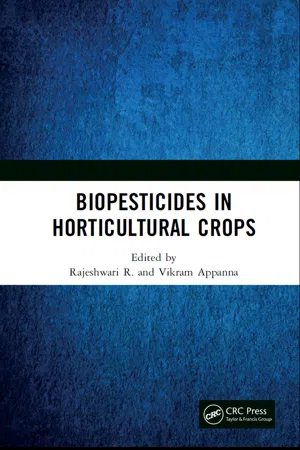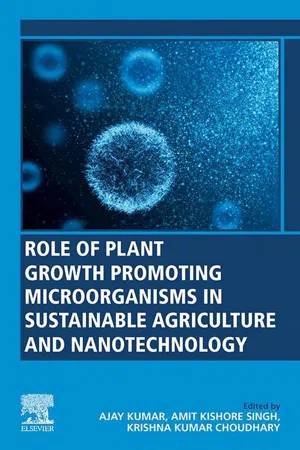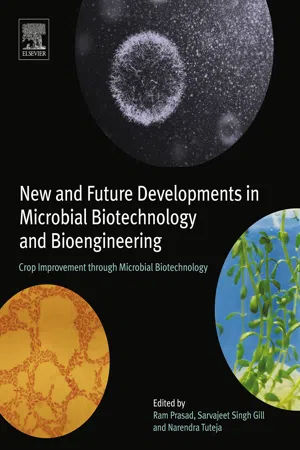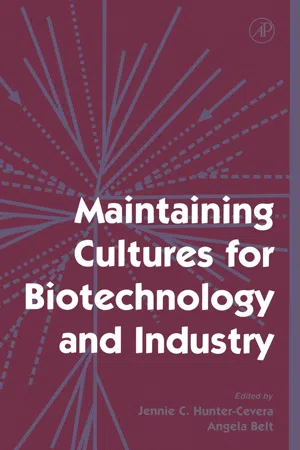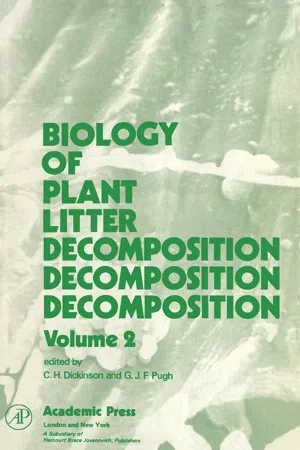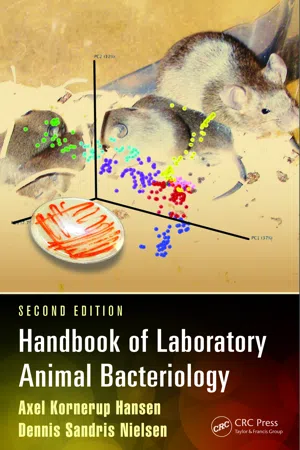Biological Sciences
Actinomycetes
Actinomycetes are a group of bacteria known for their filamentous growth and ability to produce a wide range of bioactive compounds, including antibiotics. They play a crucial role in the decomposition of organic matter in soil and are important for nutrient cycling. Actinomycetes have significant biotechnological and pharmaceutical potential due to their ability to produce diverse secondary metabolites.
Written by Perlego with AI-assistance
Related key terms
1 of 5
12 Key excerpts on "Actinomycetes"
- eBook - ePub
- Rajeshwari R., Vikram Appanna, Rajeshwari R., Vikram Appanna(Authors)
- 2021(Publication Date)
- CRC Press(Publisher)
15Role of Actinomycetes in Insect Pest and Plant Disease ManagementMahesh S. YandigeriICAR-National Bureau of Agriculture Insect Resources, BangaloreIntroduction
The Actinomycetes are gram positive bacteria which have a characteristically high G+C content in their DNA (>55%). The name “Actinomycete” derives from the Greek aktis (a ray beam) and mykes (fungus) and was given to these organisms from initial observations of their morphology. The Actinomycetes were originally considered to be an intermediate group between bacteria and fungi but now recognized as prokaryotic. They are phenotypically diverse and are found in most natural environments.Actinomycetes are cosmopolitan in nature and encompass >80 genera and provide 80% of bioactive compounds as well as 3,500 antibiotic secondary metabolites. They are also used for management of pests and pathogens, bioleaching of metals, increasing soil fertility, generating biofuels, monitoring pollutants and waste treatment. The necessary extreme adaptions of extremophilic organisms to all aspects suggest that a wide variety of biomolecules may find application in existing and future biotechnological processes. Streptomyces species form a dominant group among the Actinomycetes and have varied industrial as well as agricultural applications. They are also used as potential biological control agents to suppress a number of diseases.Among actinobacteria, Streptomyces is the largest genus and the type genus of the family Streptomycetaceae (Fig. 1 ). Over 500 species of Streptomyces bacteria have been described. Streptomyces are predominantly in soil and decaying vegetation, most streptomycetes produce spores and are noted for their distinct “earthy” odor which results from production of a volatile metabolite, geosmin. Streptomycetes produce over two-thirds of the clinically useful antibiotics of natural origin (e.g., neomycin, chloramphenicol). The now uncommonly used streptomycin takes its name directly from Streptomyces. Streptomycetes are infrequent pathogens, though infections in human such as mycetoma can be caused by S. somaliensis and S. sudanensis and in plants can be caused by S. caviscabies and S. scabies - eBook - PDF
Biofertilizers
Study and Impact
- Mohd Imran Ahamed, Rajender Boddula, Mashallah Rezakazemi(Authors)
- 2021(Publication Date)
- Wiley-Scrivener(Publisher)
Almost more than 100 genera of Actinomycetes are natural inhabitants of soil [12]. Actinomycetes belong to the order Actinomycetetales and can be distinguished from other microbes with elevated levels of G+C content (74 mol %) [13, 14]. These gram-positive bacteria exist as saprophytes in the soil [15]. Being saprophytic soil inhabitants, they possess the ability to decompose organic matter like lignocelluloses and various types of complex carbohydrates like starch and chitin [16]. Morphologically, they show mycelia growth which culminates in sporulation. Actinomycetes usually exist in significantly high numbers in semi-arid soil environ- ments although very little numbers of Actinomycetes have also been known to exist in other climatic conditions too [17]. Actinomycetes usu- ally prefer low level of moisture for growth and survival and are very well acclimatized to semi-dry conditions [18] probably due to their ability to sporulate even under dry conditions [19]. Actinomycetes are mesophilic in nature, though some species may be found in thermophilic habitats too [20]. They can also grow as epiphytes and have a wide host range [21, 22]. Recently, Actinomycetes have garnered a lot of interest in microbiolo- gists because of their diverse properties which makes them a good source for development of bioinoculants [23, 24]. Actinomycetes are very import- ant microbes which can promote the overall vigor and yield of crop plants. They can be introduced directly into soil or can be applied to crop seeds [25, 26]. Actinomycetes are known to directly influence growth of plants by mechanisms like nitrogen fixation, phosphate solubilization, produc- tion of growth hormones, or indirectly by scavenging of iron by sidero- phore production and hence protection of plants from pathogens [27]. Also, they influence their growth by magnifying their sufferance to various stress conditions [28, 29]. A well-known genus of Actinomycetes is Streptomyces [30]. - eBook - ePub
- Ajay Kumar, Amit Kishore Singh, Krishna Kumar Choudhary(Authors)
- 2019(Publication Date)
- Woodhead Publishing(Publisher)
10Role of Actinomycetes in bioactive and nanoparticle synthesis
Akanksha Gupta1 , Divya Singh2 , Sandeep Kumar Singh1 , Vipin Kumar Singh1 , Anand Vikram Singh1 and Ajay Kumar1 ,1 Center of Advanced Study in Botany Institute of Science, Banaras Hindu University, Varanasi, India,2 Department of Chemical Engineering & Technology, Indian Institute of Technology, Banaras Hindu University, Varanasi, IndiaAbstract
Actinomycetes are commonly known as filamentous, Gram-positive, spore-forming actinobacteria and are considered as both bacteria and fungi. In recent decades, Actinomycetes have been used as a resource for the production of bioactive compounds and nanoparticles. Actinomycetes are also rich sources of various enzymes that have industrial importance and of many bioactive compounds with a diverse range of pharmaceutical properties like antibiotics, antimicrobials, antibiotics, etc. Today Actinomycetes are also being used in nanotechnology for the synthesis of various nanoparticles used in sustainable agricultural processes as nanofertlizers or biocontrol agents. In this chapter, we summarize the role of Actinomycetes in sustainable agriculture, in bioactive compound production, and in the field of nanotechnology.Keywords
Actinomycetes; bioactive compounds; sustainable agriculture; nanoparticles; nanotechnology10.1 Introduction
The continuous and excessive use of chemical fertilizers and pesticides in traditional agriculture causes severe concern for the health and productivity of plant, soil, human beings, and the surrounding environments from last few decades. In this regard, beneficial microbes appear as better alternative of chemical pesticides, due to ecofriendly nature, less expense, and suitable for maintaining nutrient availability of both soils and plants. (Jeffries et al., 2003 ). Soil microbiota is composed of many beneficial microbes such as bacteria, fungi, Actinomycetes, etc. Actinomycetes are a group of aerobic, Gram-positive bacteria that form thread-like structures in soil (Ames et al., 1984 ; Nonomura, 1989 ; Halder et al., 1991 ; Elliott and Lynch, 1995 - No longer available |Learn more
- Margaret Rodriguez(Author)
- 2016(Publication Date)
- Cengage Learning EMEA(Publisher)
This often mislabeled and misidentified family of bacteria has the same potential for becoming a pathogen as most bacteria. The study of its pathogenicity toward competing bacterial strains has given researchers insights into the most effective ways to combat bacteria by using the defense tactics of one of their own kind. Clinical Significance Topic been used in the development of important antibiotic drug formulations. Structurally, these bacteria have varied shapes, sizes, and characteristics. Some are aerobic while others are facultative anaerobes. Many have unique filamentous hyphae that re- semble the mycelia of eukaryotic fungal organisms. This has contributed to confusion among scientists in the past who have assigned taxonomic names that imply classification as fungi (myco 5 fungi except in Mycobacterium spp., which are bacteria). Scientists have sequenced the genomes of 44 species of Actinobacteria. Actinomyces The genus Actinomyces comprises species of Gram-positive, microaerophilic to facultative anaerobic, non-spore-forming, filamentous rods. They belong to the class Actinobacteria. Commensal to the mouth, nose, and throat of animals and humans, these bacteria have a distinct “dust bunny” appear- ance when growing as filaments. Actinomyces are often mis- identified as fungi because of their appearance. Actinomyces israelii is the normally non-pathogenic species associated with the upper aerodigestive tracts of humans that becomes pathogenic after dental procedures or abscess formation. There is discussion in the literature that proposes that Actinomyces works as a co-pathogen with other species of bacteria and that, as an individual entity, it is not an opportu- nistic pathogen (see Figure 14-1). Actinomycosis Actinomyces bovis was first isolated in 1877 as the causative agent of actinomycosis in cattle, a condition called “lumpy jaw” because of the suppurative destruction of cattle jaw bones and soft tissues. - eBook - ePub
New and Future Developments in Microbial Biotechnology and Bioengineering
Crop Improvement through Microbial Biotechnology
- Ram Prasad, Sarvajeet Singh Gill, Narendra Tuteja(Authors)
- 2018(Publication Date)
- Elsevier(Publisher)
These organisms have shown a great morphological diversity that is reflected very well in their habitats and the cellular products they produce (Figs. 1 and 2). They are a group of prokaryotic organisms belonging to gram-positive bacteria having characteristic high “G + C” content in their genomes with various metabolic possibilities (Goshi et al., 2002). They roughly form 100 genera and 1000 species mainly inhabiting different types of soils including agricultural soils and have worth potential of recycling natural minerals and organic substances in the natural world. About 61% of all bioactive microbial metabolites have been extracted from Actinomycetes (Moncheva et al., 2002). The most common antibiotic producing soil microorganisms belong to the genus Streptomyces. About two-third (> 4000) of naturally occurring antibiotics including aminoglycoside, anthracyclines, chloramphenicol, β-lactams, macrolides, and tetracyclines have been discovered from members of this genus (Goodfellow et al., 1988). Actinomycetes have shown various implications that include plant growth promotion, induction of various physiological and defense pathways, biocontrol agents, improvement in nutritional values (Doumbou et al., 2002), development of probiotics to fulfill nutrient requirement (Tan et al., 2009), production of novel bioactive molecules (Lam, 2006), tools for easy genetic manipulations for strain improvement (Bhattacharyya and Sen, 2004), and role in biodegradation and bioremediation of complex organic materials like lignocelluloses (Crawford, 1978), heavy metals, and petroleum contaminants (Baniasadi et al., 2009). Production of large number of antimicrobial compounds by various species of Actinomycetes has already been reported (Berdy, 2005), and antagonistic impact of Actinomycetes on pathogenic organisms has been documented by many workers (Gyenis et al., 2003 ; Michaud et al., 2002 ; Abd-Allah, 2001 ; Patil et al., 2010) - eBook - PDF
Actinobacteria
Basics and Biotechnological Applications
- Dharumadurai Dhanasekaran, Yi Jiang, Dharumadurai Dhanasekaran, Yi Jiang(Authors)
- 2016(Publication Date)
- IntechOpen(Publisher)
Section 2 Bioprospecting Chapter 7 Production of Antibacterial Compounds from Actinomycetes Letizia Lo Grasso, Delia Chillura Martino and Rosa Alduina Additional information is available at the end of the chapter http://dx.doi.org/10.5772/61525 Abstract Actinomycetes are soil-dwelling Gram-positive bacteria, industrially relevant as producers of a wide range of bioactive secondary metabolites, including many anti‐ biotics of clinical and commercial importance. The understanding of actinomycete biology has been based on extensive studies on the model organism Streptomyces coelicolor over many years and on the availability of its complete genome sequence. This bacterium has an unusual complex develop‐ mental cycle that includes programmed cell death phenomena that make this bacte‐ rium a multicellular prokaryotic model. Morphological differentiation in S. coelicolor is strictly related to physiological dif‐ ferentiation: indeed the onset of morphological differentiation generally coincides with the production of secondary metabolites. During cell death, degradative pro‐ teins are synthesized and involved in an extensive degradation of some cellular constituents (proteins and lipids) used for a second growth phase, that is accompa‐ nied by antibiotic production. If on one hand, many factors with pleiotropic activity have been identified as key players to control both morphological and physiological differentiation in S. coelicol‐ or , on the other hand, for most Actinomycetes, mechanisms and factors governing morphological and physiological processes have not been deeply investigated. This chapter reviews the regulatory mechanisms known to control antibiotic pro‐ duction in Actinomycetes and both genetic and physiological methods adopted to improve antibiotic yields. Keywords: Antibiotic production, Actinomycetes, genetic engineering, regulation, heterologous expression © 2016 The Author(s). - Jennie C. Hunter-Cevera, Angela Belt(Authors)
- 1996(Publication Date)
- Academic Press(Publisher)
MAINTAINING CULTURESFOR BIOTECHNOLOGY AND INDUSTRY Copyright 91996 by Academic Press, Inc. All rights of reproduction in any form reserved. 85 86 Alma Dietz and Sara A. Currie Classification and Diversity Actinomycetes occupy a unique niche in the scientific world. The fun- guslike filamentous growth of these organisms first led to publications in mycological journals (Hesseltine, 1960). Later studies of Actinomycetes emphasized biochemical relationships that led to the differentiation of Nocardia and Streptomyces by paper chromatography of whole-cell hydro- lysates (Becker et al., 1964). Advances in microscopic and chemotaxonomic methods have greatly enhanced the abilities of scientists to differentiate genera of Actinomycetes. Identification continues to remain difficult. Two references are helpful. One gives practical suggestions for examining actino- mycetes (Cross, 1989); the other is a guide for identifying them to genus level (Lechevalier, 1989). The individual responsible for preserving actino- mycetes must have a basic knowledge of the properties of actinomycete cultures. In 1948 three families and five genera of the Order Actinomyce- tales were recognized (Breed et al., 1948). At the present time over 80 genera have been described (Dietz, 1988). Current classifications use suprageneric groups (Goodfellow, 1989). Other references (Buchanan and Gibbons, 1974; K~impfer et aL, 1991; Sneath et al., 1986; Williams et al., 1989) are also useful for the taxonomist and the curator. It must be remem- bered that classifications reflect the thinking of the author(s), and that errors may occur, resulting in incorrect descriptions of a culture (Staley and Krieg, 1986). Industrial Importance In the mid-1940s pharmaceutical companies in the United States initi- ated screening programs to find and isolate cultures that could be induced in the laboratory to produce products for the treatment of infectious diseases.- eBook - PDF
Actinobacteria
Application in Bioremediation and Production of Industrial Enzymes
- Maria Julia Amoroso, Claudia Susana Benimeli, Sergio Antonio Cuozzo(Authors)
- 2013(Publication Date)
- CRC Press(Publisher)
Values represent means ± SE, n = 7. 16 Actinobacteria Aspects of ecological importance and applications of rhizospheric Actinomycetes Availability of nutrients in the rhizosphere is controlled by the combined effects of soil properties, plant characteristics, and the interactions of plant roots with microorganisms and the surrounding soil (Bowen and Rovira 1992). The rhizosphere is characterized by a high concentration of easily degradable substrates in root exudades, such as sugar, organic acids, amino acids and others (Lynch and Whipps 1990), which leads to a proliferation of microorganisms and a higher density compared to the bulk soil (Foster 1986, Marschner and Rengel 2007). Microorganisms like bacteria, fungi, Actinomycetes, and microalgae play a key role in organic matter decomposition, nutrient cycling and other chemical transformations in soil, particularly in the rhizosphere (Andrade 2004, Murphy et al. 2007). Actinomycetes are the most widely distributed group as saprophytic soil inhabitants (Takisawa et al. 1993). They are known to be common rizoplane and rhizosphere-colonizing bacteria (Frioni 2006, Solans and Vobis 2003), which have a high capacity to produce several types of extracellular enzymes to degrade complex macromolecules (McCarthy 1989), playing an important role in the decomposition of recalcitrant biopolymers of plant waste (McCarthy and Williams 1992). Also, between biopolymers that degrade are starch, cellulose, hemicellulose, pectin, lignin, lignocellulose, keratin (Solans and Vobis 2003), humus, lignin and chitin (Semèdo et al. 2001). At the end of the degradation processes, the products are again available in the soil (Vobis and Chaia 1998). Actinomycetes utilize a wide range of carbon sources, degrade complex polymers such as lignin Figure 5. Nodulated roots of O. trinervis , coinoculated with Frankia+Actinoplanes . a) Glass tube culture after removing the sand-vermiculite substrate. - R C Ray(Author)
- 2005(Publication Date)
- CRC Press(Publisher)
CONCLUDING REMARKS There is no doubt that Actinomycetes are a very important group of microorganisms and their products have high commercial value. They can play a major role in the welfare of human beings as well as in agriculture and Microbial Biotechnology in Agriculture and Aquaculture 323 aquaculture. Consequently, any significant discovery from Actinomycetes research will greatly contribute to economic development. The discovery of any new novel compounds from Actinomycetes, however, is still an extremely expensive venture. The detection of any active compound involves several steps of tedious purification, which may require specialized techniques and equipment. Nevertheless, in pursuit of novel discovery, high input value can be simply ignored. It has been mentioned earlier that most if not all of the discoveries of novel compounds from Actinomycetes rest on the hands of private firms; thus, information on potential strains and their products are shelved, making it particularly unavailable to prospective competitors. This is the reason why for the past few years, there was not much research on Actinomycetes. The fact that more and more antibiotics are coming out in the market reveals that ever since, the research and discovery of new compounds has been a continuous process. It is thus suspected that voluminous studies have been conducted especially on antibiotic production mostly by private firms. Recently, there have been increasing amount of information made available mostly from government and private research institutions. Surprisingly, there is now a growing interest of private institutions to collaborate with government researchers in this kind of endeavour. The initiative of both research groups to conduct and share important findings on actinomycete researches has been so encouraging, mainly to fellow researchers and students who are also working on Actinomycetes and related fields.- eBook - PDF
- C.H. Dickinson(Author)
- 2012(Publication Date)
- Academic Press(Publisher)
These spores can be produced after a very short period of vegetative growth (Mayfield et al., 1972) or by the subdivision of the mycelium into fragmentation spores. 9. Actinomycetes 271 (2) The Actinomycetes are nutritionally versatile, being able to grow both on rich substrates and on those containing a minimum or even an apparent lack of nutrients. For example, a common isolation medium consisting of tap water agar (Lechevalier, 1964) will allow the development of taxa capable of growing on richly supplemented media such as blood agar. (3) The order contains organisms able to attack and metabolize a wide variety of substrates including naturally occurring and synthetic compounds that are usually resistant to microbial decomposition. (4) Following active periods of growth they produce a wide variety of secondary metabolites which include antibiotically active compounds which might give them an advantage in certain microsites. (5) The ability to form a mycelium allowing radial growth facilitates colonization of organic debris away from the initial growth centre. These properties are important in the role of Actinomycetes as soil organisms and will be considered in relation to their activities in plant litter. II. Classification Actinomycetes have a widespread distribution and are not uncommon in litter. Since taxonomists have been unable to produce a stable classification or workable identification schemes for the Actinomycetes the microbial ecologist does well to characterize his isolates even to the generic level. Sometimes there are difficulties in allocating strains to well established genera such as Streptomyces, Nocardia and Mycobacterium> and the sub-generic classification of these taxa is difficult even for the specialist. An even greater problem is that of assigning a specific name to isolates of genera such as the Streptomyces where over 400 species descriptions exist resulting from the absence of generally accepted and reliable diagnostic characters. - eBook - PDF
Antimicrobials
Synthetic and Natural Compounds
- Dharumadurai Dhanasekaran, Nooruddin Thajuddin, A. Panneerselvam, Dharumadurai Dhanasekaran, Nooruddin Thajuddin, A. Panneerselvam(Authors)
- 2015(Publication Date)
- CRC Press(Publisher)
Beijerinck (1900) and Eriko (2002) established that acti-nobacteria occur in great abundance in the soil and have a great role in the management of microbial stability with the production of antibiotic substances. Actinobacteria live in soil and decompose organic matter such as cellulose, hemicellulose, pectin, and chitin. In the drug discovery, these microorganisms are widely recognized for their ability to produce secondary metabolites with commercially viable antibiotic activity. Actinobacteria were first recognized as a common and important group of soil microorganisms (Waksman et al., 1941; Berger et al., 1949). Streptomycin, the first antibiotic for tuberculosis, was derived from the largest genus of actinobacteria, Streptomyces ; erythromycin and tetracycline are two other common medicines derived originally from these microorganisms. Most streptomycetes and other actinobacteria produce a diverse array of antibiotics, including aminoglycosides, macrolides, peptides, polyenes, polyether, and tetracyclines. In searching for new antibiotics, over 1000 different bacteria (including actinobacteria), fungi, and algae have been investigated. To prevent exponential emergence of microorganisms becoming resistant to the clinically available antibiotics already marketed, the periodic replacement of the existing antibiotics is necessary. Thus, the microbiologists/pharmacologists have regularly screened/searched the novel antibiotics particularly from microorganisms. 120 Antimicrobials: Synthetic and natural compounds 7.3 Types of antibiotics On the basis of inhibitory action against different types of pathogenic microorganisms, the antibiotics are grouped as antibacterial, antifungal, antiparasitic, antiviral, anticancer, etc. They also classified as broad-spectrum and narrow-spectrum antibiotics as they possess inhibitory action on several pathogenic microorganisms as well as single pathogens, respectively. - eBook - PDF
- Axel Kornerup Hansen, Dennis Sandris Nielsen(Authors)
- 2014(Publication Date)
- CRC Press(Publisher)
213 chapter eleven Actinobacteria 11.1 Introduction Actinobacteria are Gram-positive bacteria that are most frequently culti-vable, although it may be more or less laborious. Although they are mostly considered as soil bacteria, they are standard members of the rodent gut, 1 dispersed on a range of different species; most of these species are not known to have any impact on the animal and therefore are not dealt with further in this text. Micrococcaceae exhibit some cross-identification issues with the pathogenic Staphylococcus spp., while Corynebacteriaceae, Actinomycetaceae, and Mycobacteriaceae contain pathogenic species; finally, Bifidobacteriaceae contain probiotic bacteria with a symbiotic impact on the animal, which may also make a difference in the animals when applied as animal models. 11.2 Micrococcaceae Micrococcaceae in laboratory animals have previously been grouped together with the Firmicutes family Staphylococcaceae, which has mostly been based on morphology. Both grow easily on even simple media as Contents 11.1 Introduction ........................................................................................... 213 11.2 Micrococcaceae ...................................................................................... 213 11.3 Corynebacteriaceae ................................................................................ 214 11.3.1 Characteristics of infection ...................................................... 215 11.3.2 Characteristics of the agent ...................................................... 216 11.4 Actinomycetaceae .................................................................................. 216 11.4.1 Actinomyces .................................................................................. 216 11.4.2 Arcanobacterium ......................................................................... 218 11.5 Mycobacteriaceae ..................................................................................
Index pages curate the most relevant extracts from our library of academic textbooks. They’ve been created using an in-house natural language model (NLM), each adding context and meaning to key research topics.
